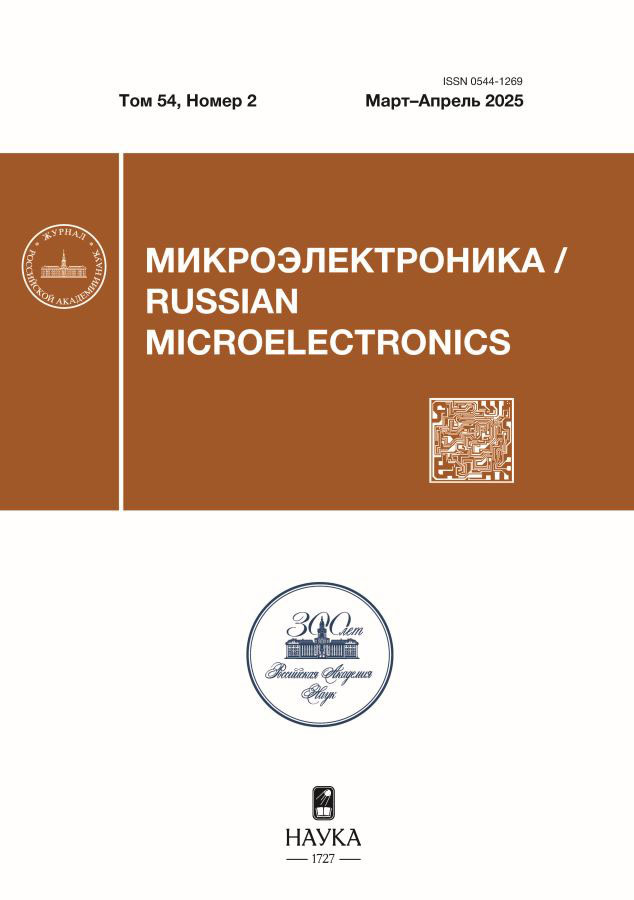Precision etching of aluminum conductors in the technology of switching devices of microsystems technology
- 作者: Didyk P.I.1, Zhukov A.A.2
-
隶属关系:
- UVN Scientific and Production Enterprise
- Moscow Aviation Institute
- 期: 卷 54, 编号 2 (2025)
- 页面: 182-190
- 栏目: TECHNOLOGIES
- URL: https://ruspoj.com/0544-1269/article/view/687130
- DOI: https://doi.org/10.31857/S0544126925020075
- EDN: https://elibrary.ru/FUTAWJ
- ID: 687130
如何引用文章
详细
Experimentally obtained precision technology of forming a controlled profile of aluminum conductive paths with a specified resistance is presented. The technology is based on anisotropic plasma-chemical etching of aluminum in the gas mixture BCl3 – Cl2 with subsequent precision adjustment of path resistance by the “dry” plasma-chemical method. It is shown that in order to ensure the highest quality plasma chemical etching of aluminum with minimal under etching under the photoresist mask, with minimal inclination of the aluminum conductive path profile and absence of defectiveness of the etching pattern and stratified areas, it is necessary to use a multistage iterative technological process with technological operations of surface preparation before etching and operations of polymer and photoresist removal after etching.
全文:
作者简介
P. Didyk
UVN Scientific and Production Enterprise
编辑信件的主要联系方式.
Email: Felix_engine@mail.ru
俄罗斯联邦, Moscow
A. Zhukov
Moscow Aviation Institute
Email: zhukovаа@mail.ru
俄罗斯联邦, Moscow
参考
- Nakazawa A.M., Verdonck P. Plasma etching of aluminium using BCl3–Cl2 mixtures. LSI-PEE-EPUSP, Av. Prof. Luciano Gualberto trav 3, 158, 05508-900 São Paulo, SP.
- Hess D.W. Plasma etching of aluminium. Solid State Technology, vol. 34, № 4, pp. 189–194, 1981.
- Riley P.E. Plasma etching of aluminium metallizations for ultralarge scale integrated circuits. Journal of the Electrochemical Society, vol. 140, pp. 1518–1522, 1993.
- Lutze J.W., Perera A.H., Krusius J.P. Anisotropic reactive ion etching of aluminium using Cl2, BCl3 and CH4 gases. Journal of the Electrochemical Society, vol. 137, № 1, pp. 249–252, 1990.
- Lehmann H.W., Widmer R. Reactive sputter etching of Al in BCl3. Microelectronic Engineering, № 1, pp. 3–27, 1983.
- Hess D.W., and Bruce R.H. In “Dry Etching for Micro- electronics,” R.A. Powell, Editor, pp. 1–38, North-Hol- land Physics Publishing, Amsterdam, 1984.
- Danner D.A., Dalvie M., and Hess D.W. J. Electrochem. Soc. 134, 669 (1987).
- Hess D.W. Plasma Etch Chemistry of Al and Al Alloy Films. Plasma Chemistry and Plasma Processing 1982, 2 (2), 141–155.
- Donnelly V.M., Kornblit A. Plasma etching: Yesterday, today, and tomorrow. Journal of Vacuum Science & Technology A: Vacuum, Surfaces, and Films 2013, 31 (5).
- Bruce R.H., Malafsky G.P. High Rate Anisotropic Aluminum Etching Journal of Vacuum Science & Technology 1983, 130 (6), 1369–1373.
- Frank W.E. Approaches for patterning of aluminum. Microelectronic Engineering 1997, 33, 85–100.
- Yamanaka M. Dry Etching Method for Aluminum Alloy Etching Gas Therefor. 5, 837, 616, 1998.
- Pivovarenok S.A., Dunayev A.V., Efremov A.M., Svettsov V.I. Dry etching of aluminum in chlorine. Chemistry and Chemical Technology, 2008, vol. 51, issue 11, p. 17–21.
- Levinstein H.J., and WangD.N. US patent 4,256,534 (17 Mar. 1981).
- Shuichi Saito, Kazuyuki Sugita and Junichi Tonotani. Effect of CHF3 Addition on Reactive Ion Etching of Aluminum Using Inductively Coupled Plasma. Japanese Journal of Applied Physics, Volume 44, Number 5R, 2005. https://doi.org/10.1143/JJAP.44.2971
- Pavel Ionov. Hydrocarbon gases for anisotropic etching of metal-containing layers. US Patent 6,010,966 (Aug 7, 1998).
- Czuprynski P., Joubert O., Vallier L., Puttock M., and Heitzmann M. J. Vac. Sci. Technol. B 16, 147 (1998). https://doi.org/10.1116/1.589770
- Uvarov I.V., Marukhin N.V., Shlepakov P.S., Lukichev V.F. Calculation of operating characteristics of MEMS switch with increased capacitance ratio. Microelectronics, 2020, Vol. 49, No. 4, pp. 271–280.
- Tsai Z-Y., Shih P-J., Tsai Y-Ch., Dai Ch-L. Manufacturing and Testing of Radio Frequency MEMS Switches Using the Complementary Metal Oxide Semiconductor Process. Sensors 2021, 21, 1396. P. 1–12. https://doi.org/10.3390/s21041396
- Garnier P., Vessa T., Larrea A.S., Pernet B., Gomez Y., Barge D., Torres A., Travel B., Hederson C., and Levy D. ECS Transactions, 11 (2), p. 257–264, 2007.
- Tiwari C. et. al. Characterization of the Descum Process for Various Silicon Substrates. Abstract #2123, 224th ECS Meeting, 2013 The Electrochemical Societ.
- Angela Makie Nakazawa, Patrick Verdonck. Plasma Etching of Aluminium Using BCl3–Cl2 Mixtures. LSI-PEE-EPUSP, Av. Prof. Luciano Gualberto trav 3, 158, 05508–900 São Paulo, SP.
- Yunik A.D., Shidlovsky A.G. Using laser interferometry to determine the end time of plasma chemical etching of p-GaN and AlGaN layers of p-GaN/AlGaN/GaN heterostructure with two-dimensional electron gas. BGUIR Papers. 2022;20(7):12–19. https://doi.org/10.35596/1729-7648-2022-20-7-12-19
补充文件













